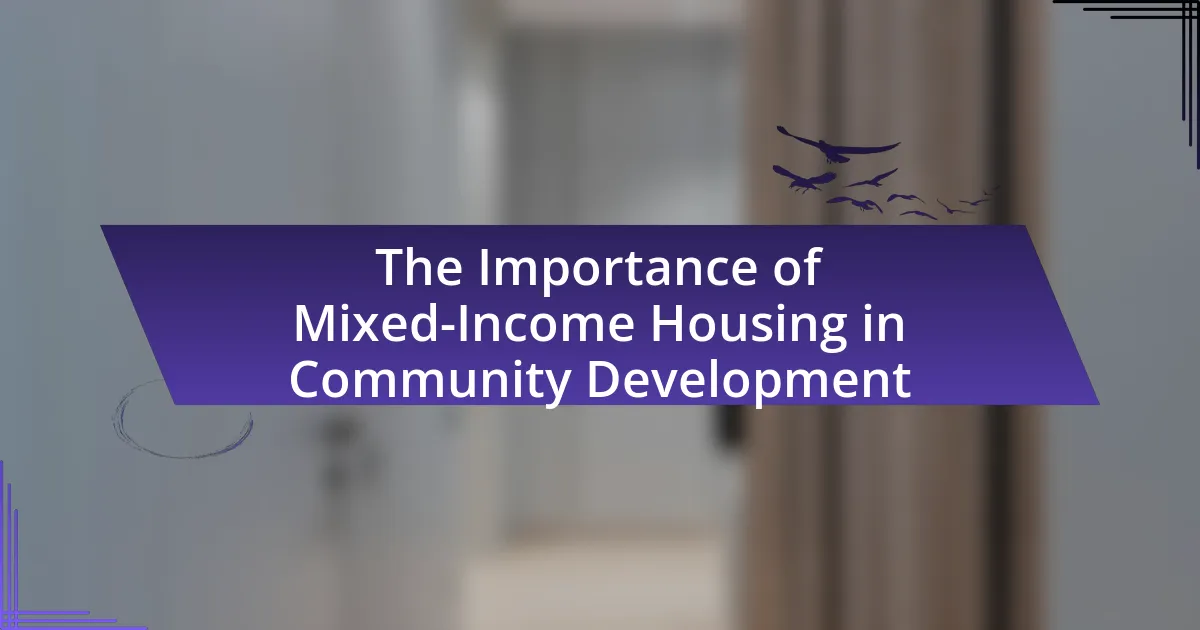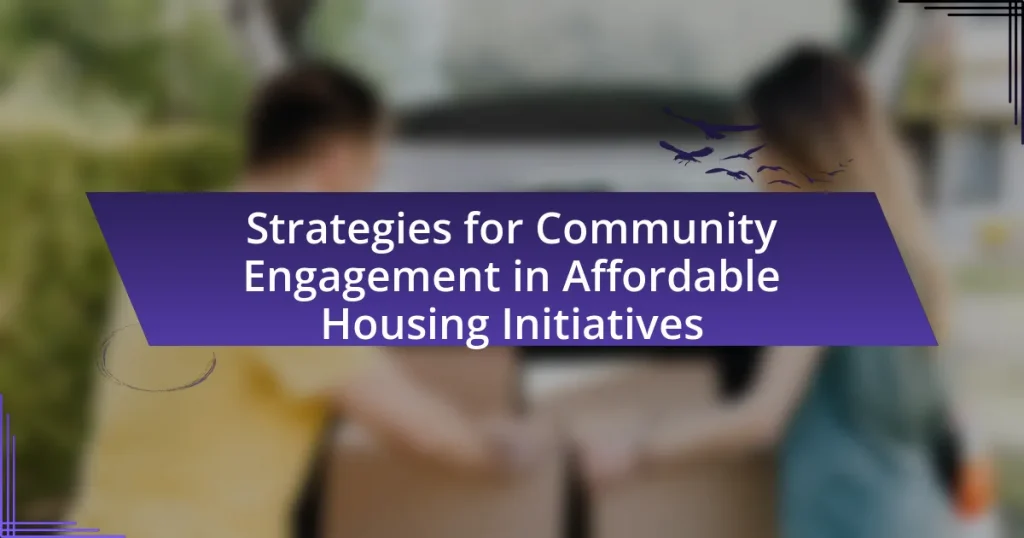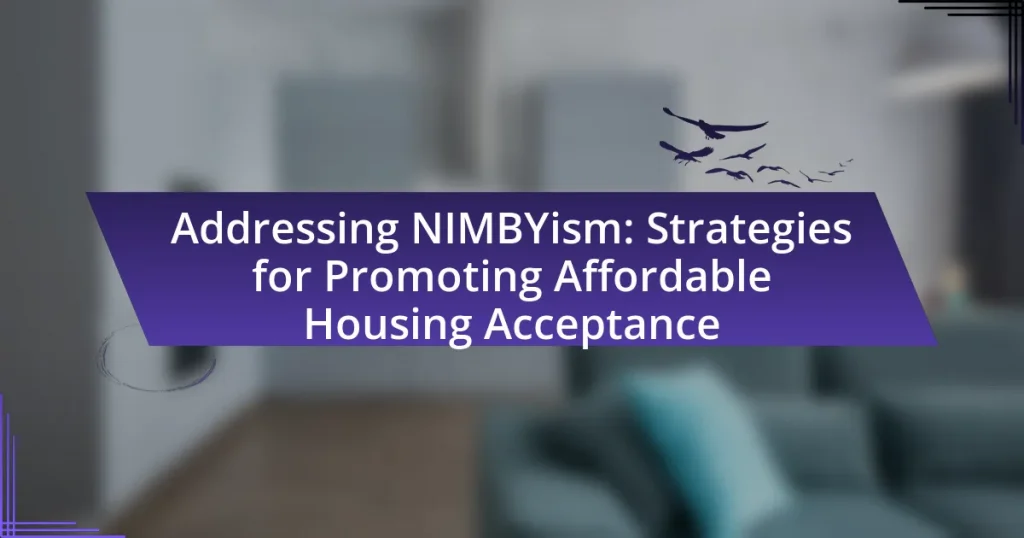Mixed-income housing is a residential development model that integrates residents from various income levels, including low-income, moderate-income, and market-rate households. This approach is crucial for community development as it promotes social integration, reduces economic segregation, and enhances access to resources and opportunities, leading to improved educational outcomes and economic mobility. The article explores the characteristics of mixed-income housing, its benefits for social cohesion and local economies, and the strategies for effective implementation in urban planning. Additionally, it addresses the challenges faced in developing mixed-income communities and offers best practices for ensuring equitable access and mitigating gentrification.
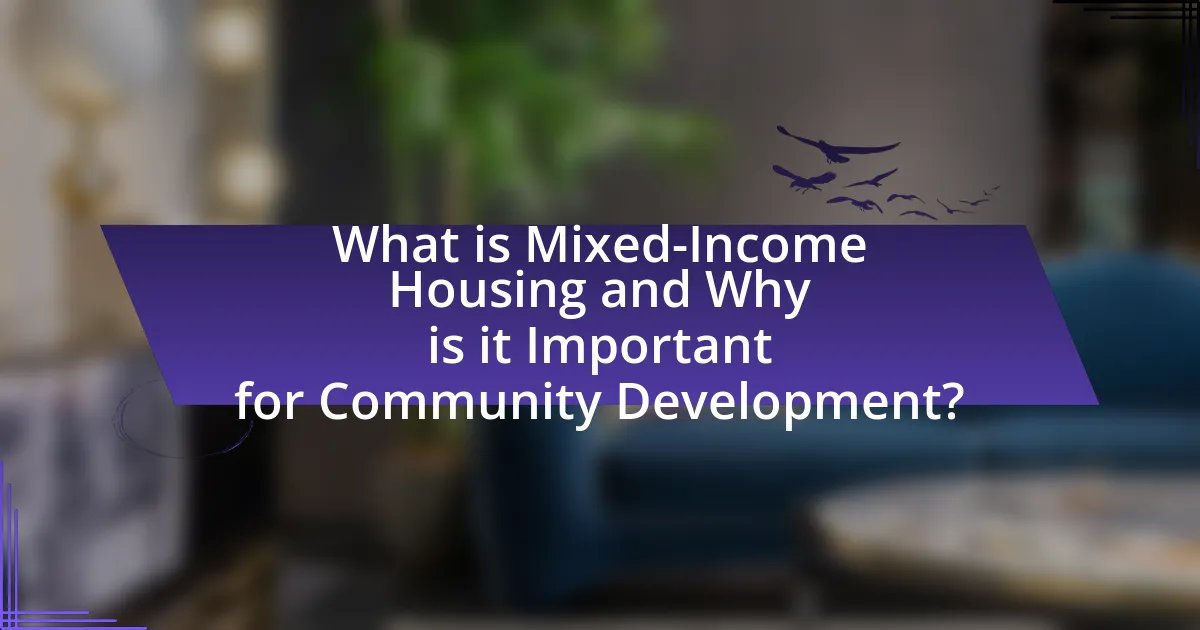
What is Mixed-Income Housing and Why is it Important for Community Development?
Mixed-income housing is a residential development that includes a diverse mix of income levels among its residents, typically combining low-income, moderate-income, and market-rate housing. This approach is important for community development because it fosters social integration, reduces economic segregation, and enhances access to resources and opportunities for all residents. Research indicates that mixed-income communities can lead to improved educational outcomes and increased economic mobility, as evidenced by studies such as the Moving to Opportunity experiment, which demonstrated that families moving to mixed-income neighborhoods experienced better life outcomes.
How does Mixed-Income Housing differ from other housing models?
Mixed-Income Housing differs from other housing models by intentionally integrating residents from various income levels within the same community, promoting social diversity and economic inclusion. Unlike traditional housing models that often segregate low-income and high-income residents, Mixed-Income Housing fosters a balanced community where individuals from different socioeconomic backgrounds can coexist. This model has been shown to enhance community stability and reduce poverty concentration, as evidenced by studies indicating that mixed-income developments can lead to improved educational outcomes and lower crime rates in comparison to single-income housing projects.
What are the key characteristics of Mixed-Income Housing?
Mixed-income housing is characterized by the integration of residents from various income levels within the same development. This approach promotes social diversity and economic inclusion, fostering a sense of community. Key characteristics include a mix of affordable and market-rate units, which ensures that lower-income families have access to quality housing alongside higher-income residents. Additionally, mixed-income developments often incorporate shared amenities and services that benefit all residents, enhancing community cohesion. Research indicates that such housing models can lead to improved educational outcomes and reduced crime rates, as seen in studies conducted by the Urban Institute, which highlight the positive impacts of mixed-income environments on community development.
How does Mixed-Income Housing promote diversity within communities?
Mixed-income housing promotes diversity within communities by integrating residents from various socioeconomic backgrounds into a single living environment. This integration fosters social interaction and collaboration among different income groups, which can lead to a more inclusive community atmosphere. Research indicates that mixed-income developments can reduce economic segregation, as evidenced by a study from the Urban Institute, which found that such housing models enhance social cohesion and improve access to resources for lower-income residents. By providing affordable housing options alongside market-rate units, mixed-income housing creates opportunities for diverse populations to coexist, thereby enriching community life and promoting equity.
What role does Mixed-Income Housing play in economic stability?
Mixed-income housing plays a crucial role in promoting economic stability by fostering diverse communities that enhance social cohesion and economic opportunities. This type of housing integrates individuals from various income levels, which can lead to increased local spending and investment in the community. Research indicates that mixed-income developments can reduce poverty concentration, thereby improving access to resources such as quality education and employment opportunities. For instance, a study by the Urban Institute found that mixed-income housing projects can lead to a 20% increase in local economic activity, demonstrating their effectiveness in stabilizing neighborhoods and promoting sustainable economic growth.
How does Mixed-Income Housing contribute to local economies?
Mixed-income housing contributes to local economies by fostering economic diversity and stability within communities. This type of housing attracts a range of income levels, which can lead to increased consumer spending in local businesses. For instance, a study by the Urban Institute found that mixed-income developments can enhance property values and stimulate local job creation, as they often lead to improved infrastructure and services. Additionally, mixed-income housing can reduce reliance on public assistance programs, thereby decreasing government expenditures and reallocating funds to other community needs.
What impact does Mixed-Income Housing have on property values?
Mixed-income housing generally has a positive impact on property values. Studies indicate that the presence of mixed-income developments can lead to increased property values in surrounding areas due to improved neighborhood stability and enhanced amenities. For instance, research published in the Journal of Urban Economics found that mixed-income housing projects in urban areas led to a 10-15% increase in property values within a half-mile radius, attributed to the diversification of income levels and the associated improvements in local services and infrastructure.
Why is Mixed-Income Housing essential for social cohesion?
Mixed-income housing is essential for social cohesion because it fosters diverse communities where individuals from various socioeconomic backgrounds interact and collaborate. This diversity promotes understanding and reduces social isolation, leading to stronger community ties. Research indicates that mixed-income developments can decrease crime rates and improve overall neighborhood satisfaction, as seen in studies conducted by the Urban Institute, which found that residents in mixed-income neighborhoods reported higher levels of trust and social engagement compared to those in single-income areas.
How does Mixed-Income Housing foster community engagement?
Mixed-income housing fosters community engagement by creating diverse living environments that encourage interaction among residents from various socioeconomic backgrounds. This diversity promotes social cohesion, as residents are more likely to participate in community activities and initiatives, leading to stronger neighborhood ties. Research indicates that mixed-income developments can reduce social isolation and increase civic participation, as seen in studies conducted by the Urban Institute, which found that residents in mixed-income communities reported higher levels of trust and engagement compared to those in single-income neighborhoods.
What are the social benefits of living in Mixed-Income communities?
Living in mixed-income communities fosters social cohesion and reduces economic segregation. These communities promote interaction among diverse socioeconomic groups, leading to increased understanding and collaboration. Research indicates that residents in mixed-income settings experience lower crime rates and improved safety, as social ties strengthen community vigilance. Additionally, mixed-income environments provide access to better resources, such as quality schools and healthcare, which benefit all residents, regardless of income level. Studies, including one from the Urban Institute, show that mixed-income developments can enhance overall community well-being and economic mobility.
How can Mixed-Income Housing be effectively implemented in urban planning?
Mixed-income housing can be effectively implemented in urban planning by integrating diverse income levels within residential developments to promote social equity and economic diversity. This approach involves zoning regulations that encourage mixed-income projects, financial incentives for developers to include affordable units, and community engagement to ensure that the needs of various income groups are met. Research indicates that mixed-income developments can reduce poverty concentration and improve access to resources, as seen in the 2010 study by the Urban Institute, which found that such housing models lead to better educational outcomes and increased economic mobility for lower-income residents.
What challenges does Mixed-Income Housing face in community development?
Mixed-income housing faces several challenges in community development, including social integration, funding disparities, and maintenance issues. Social integration is often hindered by the stigma associated with low-income residents, which can lead to tensions between different income groups. Funding disparities arise as mixed-income projects typically rely on a combination of public and private financing, making them vulnerable to economic fluctuations and policy changes. Additionally, maintenance issues can emerge due to differing expectations and responsibilities among residents, which can affect the overall quality and sustainability of the housing. These challenges can impede the effectiveness of mixed-income housing in fostering inclusive and equitable communities.
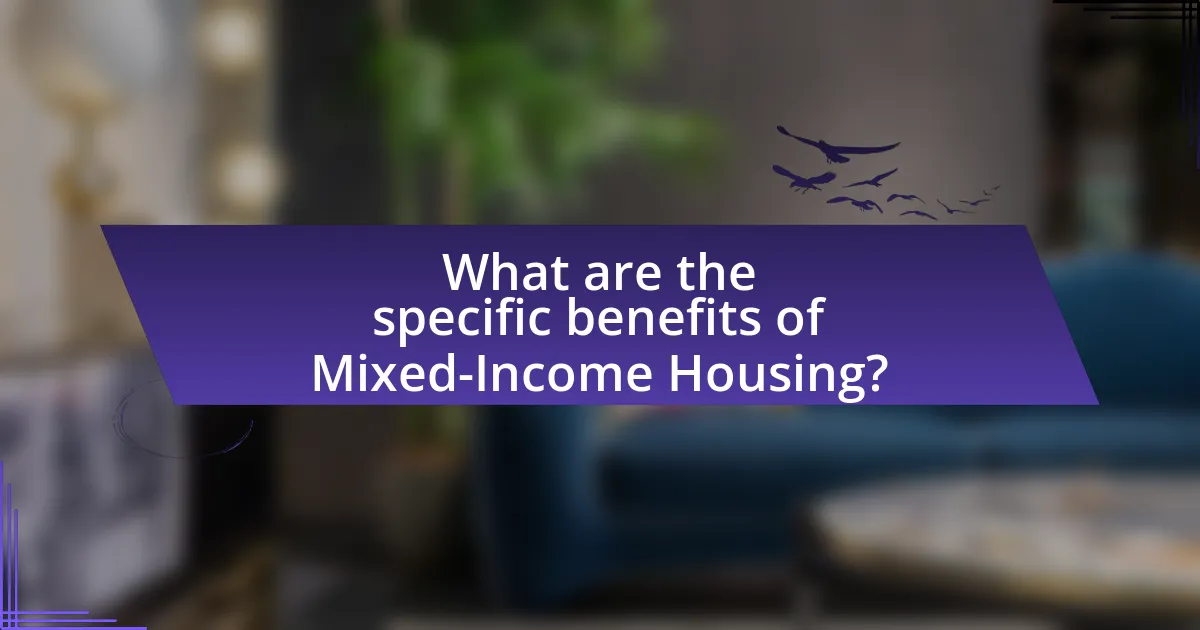
What are the specific benefits of Mixed-Income Housing?
Mixed-income housing provides several specific benefits, including economic diversity, improved social cohesion, and enhanced community stability. Economic diversity occurs as mixed-income developments integrate residents from various income levels, which can lead to increased local spending and investment in the community. Improved social cohesion is evident as residents interact across socioeconomic lines, fostering understanding and reducing stigma associated with poverty. Enhanced community stability is supported by the fact that mixed-income housing can reduce reliance on public assistance, as residents have access to better job opportunities and resources, ultimately leading to lower rates of eviction and homelessness. These benefits contribute to healthier, more resilient communities.
How does Mixed-Income Housing enhance access to resources?
Mixed-Income Housing enhances access to resources by creating diverse communities that facilitate social interaction and economic opportunities. This housing model integrates individuals from various income levels, which promotes shared access to essential services such as education, healthcare, and employment. Research indicates that residents in mixed-income developments often experience improved access to quality schools and job networks, leading to better economic mobility. For instance, a study by the Urban Institute found that mixed-income housing can reduce poverty concentration and improve overall community resources, thereby benefiting all residents.
What educational opportunities are linked to Mixed-Income Housing?
Mixed-income housing is linked to various educational opportunities, primarily through the integration of diverse socioeconomic groups that can enhance access to quality education. Research indicates that residents in mixed-income developments often benefit from improved local schools and educational programs due to increased community investment and resources. For instance, a study by the Urban Institute found that mixed-income housing can lead to better educational outcomes for children, as these environments foster social networks that support academic achievement. Additionally, partnerships between housing developers and educational institutions can create after-school programs and mentorship opportunities, further enriching the educational landscape for residents.
How does Mixed-Income Housing improve access to healthcare services?
Mixed-income housing improves access to healthcare services by fostering diverse communities that enhance social cohesion and resource sharing. Research indicates that residents in mixed-income developments often have better access to healthcare facilities due to their proximity to urban amenities and services, which are typically more abundant in mixed-income areas. For example, a study by the Urban Institute found that mixed-income housing projects lead to increased utilization of preventive healthcare services among low-income residents, as they are more likely to live near clinics and hospitals compared to those in isolated low-income neighborhoods. This integration not only reduces barriers to healthcare access but also promotes healthier lifestyles through community engagement and support networks.
What environmental benefits are associated with Mixed-Income Housing?
Mixed-income housing provides several environmental benefits, including reduced urban sprawl and improved resource efficiency. By integrating various income levels within a single community, mixed-income housing promotes higher density living, which minimizes the need for extensive land development and preserves green spaces. Additionally, these developments often encourage the use of public transportation, leading to lower greenhouse gas emissions. Studies indicate that communities with mixed-income housing can achieve a 20% reduction in vehicle miles traveled, contributing to improved air quality and reduced traffic congestion.
How does Mixed-Income Housing promote sustainable living practices?
Mixed-income housing promotes sustainable living practices by fostering diverse communities that encourage resource sharing and reduce environmental impact. This housing model integrates various income levels, which leads to a mix of residents who can collaborate on sustainability initiatives, such as community gardens and shared transportation options. Research indicates that mixed-income developments often prioritize green building practices, resulting in energy-efficient structures that lower utility costs and carbon footprints. For example, a study by the Urban Institute found that mixed-income housing projects are more likely to incorporate sustainable features like energy-efficient appliances and renewable energy sources, thereby enhancing overall community resilience and sustainability.
What role does Mixed-Income Housing play in reducing urban sprawl?
Mixed-income housing plays a crucial role in reducing urban sprawl by promoting higher density living within existing urban areas. This type of housing integrates various income levels, which encourages diverse communities and reduces the need for residents to seek affordable housing in outlying suburban areas. Studies indicate that mixed-income developments can lead to more efficient land use, as they often replace underutilized properties and support public transportation systems, thereby minimizing reliance on cars and reducing overall urban expansion. For instance, research from the Urban Institute highlights that mixed-income housing can decrease the environmental impact associated with urban sprawl by fostering walkable neighborhoods and enhancing access to amenities.
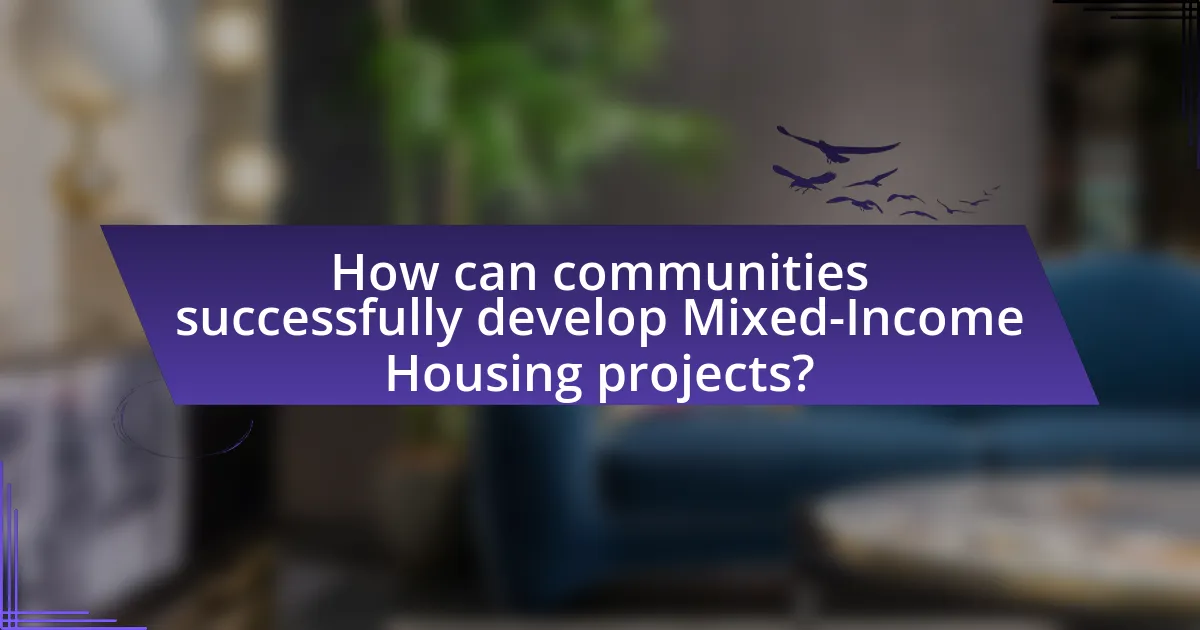
How can communities successfully develop Mixed-Income Housing projects?
Communities can successfully develop Mixed-Income Housing projects by engaging in comprehensive planning, fostering collaboration among stakeholders, and ensuring sustainable financing. Effective planning involves assessing local housing needs and integrating mixed-income strategies into broader community development goals. Collaboration among government agencies, non-profits, and private developers is crucial for pooling resources and expertise, as evidenced by successful projects in cities like San Francisco, where partnerships have led to the creation of diverse housing options. Sustainable financing can be achieved through a combination of public funding, private investment, and innovative financing mechanisms, such as tax credits, which have been shown to enhance project viability and affordability.
What best practices should be followed in Mixed-Income Housing development?
Best practices in Mixed-Income Housing development include ensuring diverse income levels, integrating affordable housing with market-rate units, and fostering community engagement. Diverse income levels promote social equity and economic diversity, which are essential for vibrant communities. Integrating affordable housing with market-rate units helps to avoid stigmatization and creates a more cohesive neighborhood. Community engagement involves involving residents in the planning process, which enhances satisfaction and ensures that the development meets the needs of all income groups. These practices are supported by studies indicating that mixed-income developments lead to improved social outcomes and economic stability in communities.
How can community input shape Mixed-Income Housing projects?
Community input can significantly shape Mixed-Income Housing projects by ensuring that the needs and preferences of diverse residents are integrated into the planning and design processes. Engaging community members through surveys, public meetings, and focus groups allows developers to gather valuable insights about local priorities, such as desired amenities, architectural styles, and accessibility features. For instance, a study by the Urban Institute found that projects incorporating community feedback are more likely to succeed in fostering social cohesion and meeting the expectations of residents. This participatory approach not only enhances the relevance of the housing solutions but also builds trust between developers and the community, ultimately leading to more sustainable and inclusive developments.
What funding sources are available for Mixed-Income Housing initiatives?
Funding sources available for Mixed-Income Housing initiatives include federal programs, state and local government grants, private investments, and philanthropic contributions. Federal programs such as the Low-Income Housing Tax Credit (LIHTC) provide significant financial incentives for developers to create mixed-income projects. Additionally, the HOME Investment Partnerships Program offers block grants to states and localities for affordable housing development. State and local governments often have their own funding mechanisms, including bonds and grants specifically aimed at supporting mixed-income housing. Private investments from real estate firms and community development financial institutions also play a crucial role in financing these initiatives. Philanthropic organizations frequently contribute funds to support mixed-income housing as part of broader community development goals.
What are common pitfalls to avoid in Mixed-Income Housing development?
Common pitfalls to avoid in mixed-income housing development include inadequate community engagement, insufficient funding, and poor design integration. Inadequate community engagement can lead to a lack of support and trust from residents, which is crucial for the success of such projects. Insufficient funding often results in compromised quality and sustainability, as projects may not be able to meet the diverse needs of different income groups. Poor design integration can create social divides, undermining the goal of fostering a cohesive community. Research indicates that projects lacking these considerations often face higher rates of vacancy and community dissatisfaction, highlighting the importance of addressing these pitfalls for successful mixed-income housing development.
How can developers ensure equitable access in Mixed-Income Housing?
Developers can ensure equitable access in mixed-income housing by implementing inclusive design principles and establishing policies that prioritize affordability and accessibility. Inclusive design principles involve creating units that cater to diverse income levels and family sizes, ensuring that lower-income residents have access to the same amenities and services as higher-income residents. Policies such as income-targeted units, where a percentage of housing is reserved for low-income families, can help maintain affordability. Research indicates that mixed-income developments can reduce poverty concentration and improve social integration, as seen in studies by the Urban Institute, which highlight the benefits of mixed-income housing in fostering community cohesion and economic mobility.
What strategies can mitigate gentrification in Mixed-Income communities?
Strategies to mitigate gentrification in mixed-income communities include implementing rent control policies, promoting affordable housing development, and enhancing community land trusts. Rent control policies can stabilize housing costs for existing residents, preventing displacement due to rising rents. For instance, cities like San Francisco have enacted rent control measures that help maintain affordability in gentrifying neighborhoods. Promoting affordable housing development ensures that a portion of new housing stock remains accessible to lower-income residents, as seen in programs like inclusionary zoning, which mandates that developers include affordable units in their projects. Community land trusts, such as those in Burlington, Vermont, allow communities to collectively own land, thereby controlling development and preserving affordability over the long term. These strategies collectively aim to balance the needs of diverse income groups and maintain the character of mixed-income neighborhoods.
What practical steps can communities take to advocate for Mixed-Income Housing?
Communities can advocate for Mixed-Income Housing by organizing local coalitions that include residents, businesses, and non-profit organizations to promote awareness and support for such developments. These coalitions can conduct community meetings to educate residents about the benefits of mixed-income housing, such as increased economic diversity and improved neighborhood stability.
Additionally, communities can engage with local government officials to influence zoning laws and policies that favor mixed-income developments. For instance, advocating for inclusionary zoning policies can ensure that a percentage of new housing units are affordable for low- and moderate-income families.
Communities can also gather data on housing needs and demographics to present compelling arguments for mixed-income housing to stakeholders. Research shows that mixed-income developments can reduce poverty concentration and improve access to resources, which can be highlighted in advocacy efforts.
Furthermore, communities can leverage social media and local media outlets to raise awareness and generate public support for mixed-income housing initiatives. By mobilizing public opinion, communities can create pressure on decision-makers to prioritize mixed-income housing in urban planning.
